10 Drunk Driving vs. High Driving Statistics & Facts: 2025 Update
-
Pete Ortiz
- Last updated:
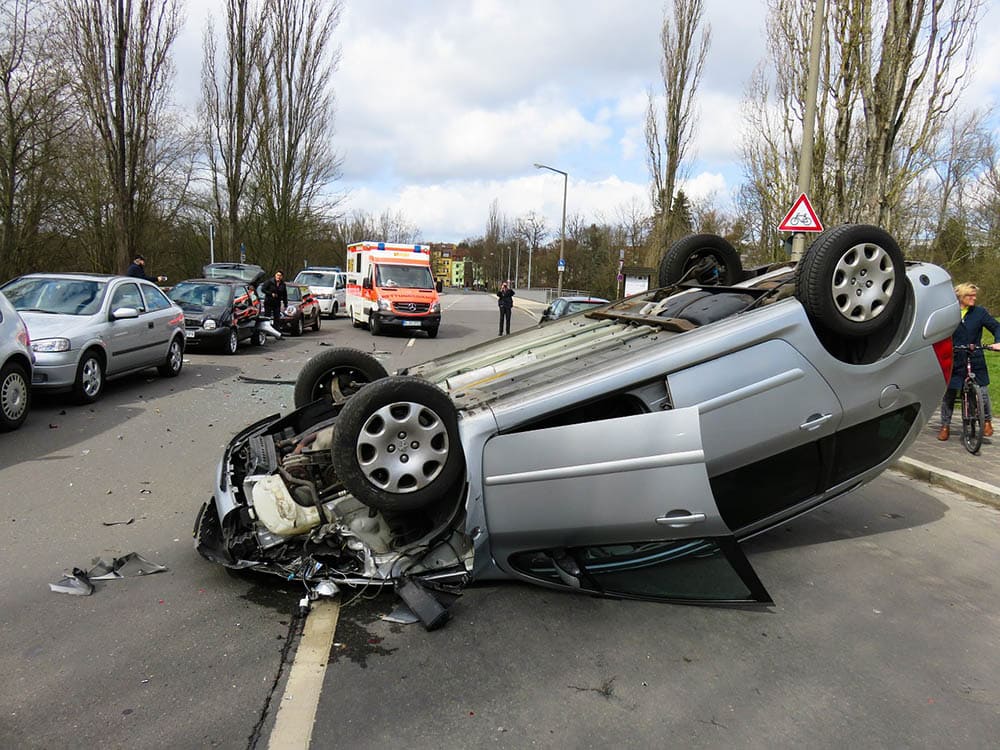
Note: This article’s statistics come from third-party sources and do not represent the opinions of this website.
Drinking and driving is a question of concern in many countries today. There are two aspects of driving under the influence: drunk driving and high driving. These two are similar, but how do we know which is worse? How dangerous is drunk driving compared to high driving?
Alcohol, marijuana, and other narcotics are all different drugs, but they have one thing in common: they impair our judgment and affect our driving abilities. If you think you can drive because you had a couple of drinks or are under the influence of another drug, then we have news for you!
Click below to jump ahead:
Top 10 Drunk Driving Vs. High Driving Statistics and Facts
- In the US, more than 25% of all deaths related to traffic accidents are directly related to alcohol impairment.
- Drunk driving accidents kill more than 10,000 people annually in the United States.
- In South Africa, 27.1% of fatal car accidents were due to drunk driving.
- Traffic accidents are the leading cause of death for teens worldwide, and roughly 33% of these accidents involve alcohol or other substance use.
- 80% of drunk driving statistics all over the world involve men.
- Forty-two states have license suspension or revocation laws enacted for drunk driving offenses.
- On average, a drunk driver in the US will drive 80 times under the influence before their first arrest.
- 4% of Americans believe that high driving has safe levels depending on the THC level of the driver.
- Around the world, 44% of drivers involved in fatal accidents tested positive for drugs.
- The number of accidents caused by drunk drivers worldwide is four times higher than accidents caused by high drivers.
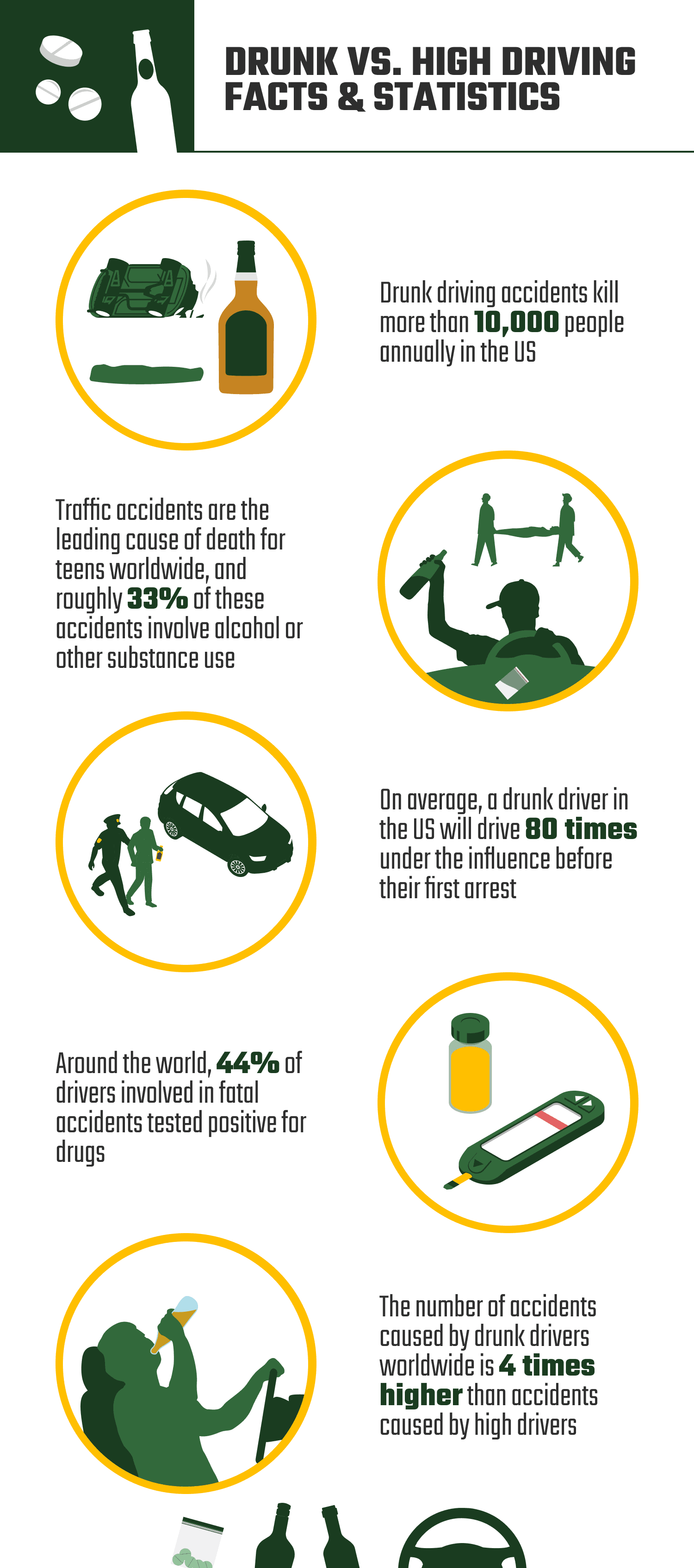
Fatalities Caused by Drunk Driving
1. In the US, more than 25% of all deaths related to traffic are directly related to alcohol impairment.
(CDC)
Alcohol is a depressant. It means that it slows down your body and mind. It can also make you unaware of your surroundings and cause the inability to react in an emergency.
Tolerance varies from person to person. What may seem like a small amount of alcohol to one person may impact someone else.
Alcohol impairment is a major contributing factor to more than one-quarter of the fatalities on our highways. Tens of thousands of people die each year from accidents resulting from poor judgment on the road due to alcohol consumption.
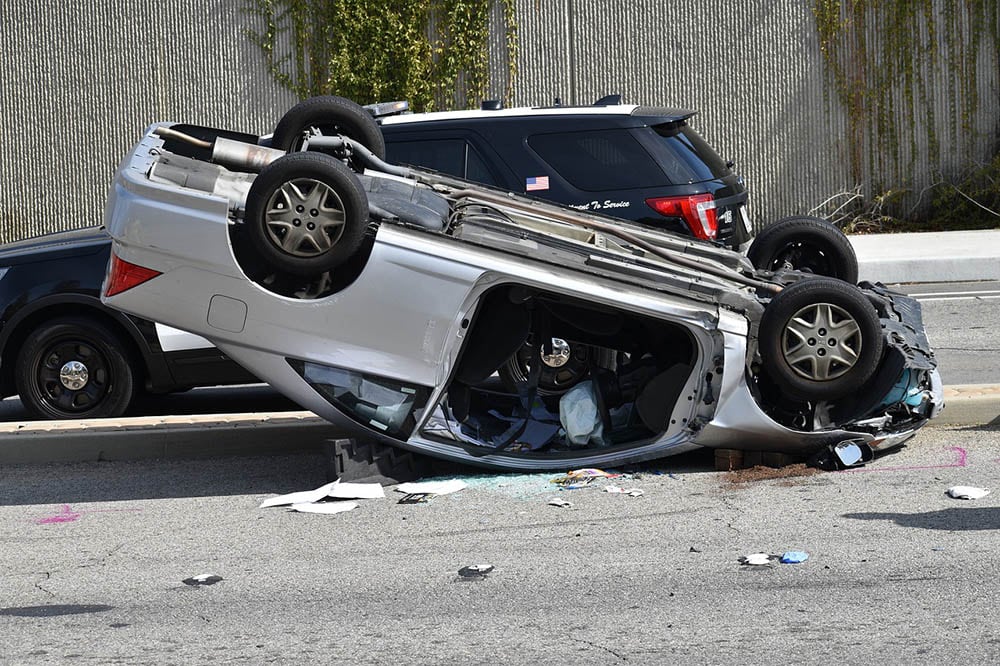
2. Drunk driving accidents kill more than 10,000 people annually in the United States.
(NHTSA)
Drunk driving is a serious issue worldwide. That said, drunk driving accidents kill many people annually in the United States alone.
The NHTSA reports that about one-third of these fatalities involve drivers with blood alcohol content levels of 0.15%. It’s twice the legal limit of 0.08%. These numbers are shocking.
But why don’t people think twice before getting on the wheels after drinking? Weigh the expense and time against the potential risks of driving drunk. If you’re going to drink all night, have a designated driver or call a cab to make sure you get home safely.
3. In South Africa, 27.1% of fatal car accidents were due to drunk driving.
(EWN)
If you drink alcohol, do not think that for a moment you are fit to drive. This is a deadly mix.
In 2020, it was reported that 27.1% of car accident deaths were caused by drunk driving. That’s a lot of families mourning the loss of loved ones.
Although not all deaths on the road are attributed to drunk driving, too often people do not realize how dangerous it is to get behind the wheel after taking alcohol.
Number of People Involved in Drunk Driving
4. Traffic accidents are the leading cause of death for teens worldwide, and roughly 33% of these accidents involve alcohol or other substance use.
(CDC)
It doesn’t take much for teen drivers to get into trouble. A lapse in judgment, a moment of distraction, and a split-second decision can have lasting consequences. According to the CDC, many parents are unaware that their children are driving after drinking alcohol or taking drugs.
Besides, many teens who drink and drive think their parents will never find out. Statistics are shocking. It’s not surprising that teens are at risk of getting in accidents involving alcohol or substance use.
Teens aren’t fully developed physically or mentally. Their bodies have not matured, so they can’t handle alcohol like adults. Additionally, they may be more impulsive and less able to make good decisions when under the influence of alcohol or drugs.
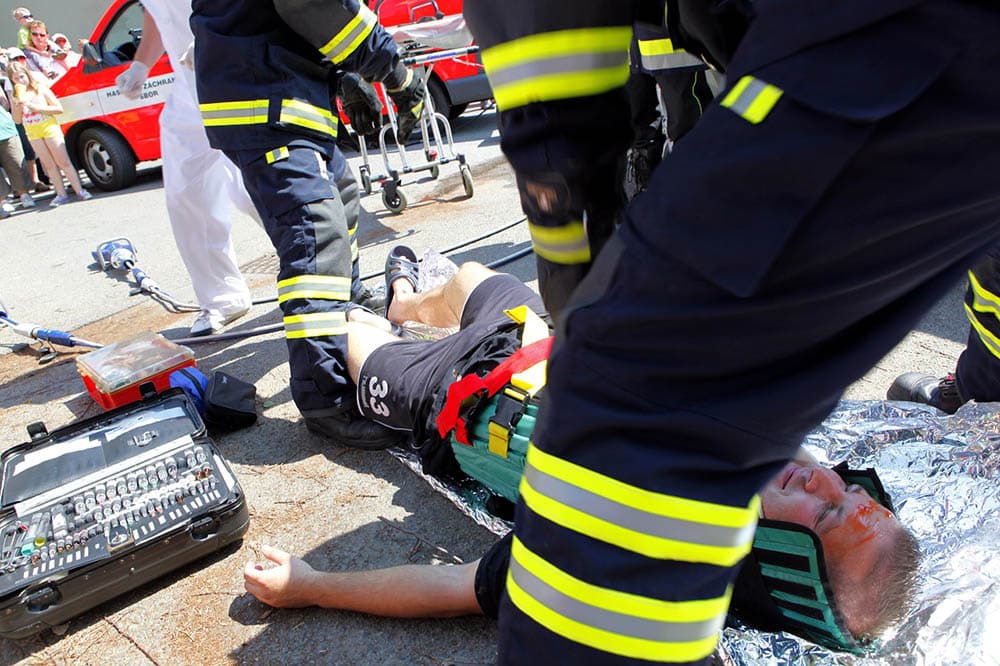
5. 80% of drunk driving statistics all over the world involve men.
(DRUNK DRIVING STATS)
More men go out drinking and partying than women do, and statistics show that more men get caught driving under the influence. It does not mean that women are not also responsible for drunk driving accidents. But the majority of traffic fatalities involving alcohol are caused by men.
Men are risk-takers and like to push their limits with alcohol and other drugs. On the other hand, women don’t feel the same pressures from society to engage in these activities and are more cautious when drinking.
Men drink more often and heavily than women. The difference is especially significant among young adults. It means a higher percentage of male drivers drive drunk than female ones.
6. Forty-two states have license suspension or revocation laws enacted for drunk driving offenses.
(RESPONSIBILITY)
Driving under the influence can lead to severe consequences. For many people, these consequences include having their license revoked. Most states have enacted laws where a person’s license can be revoked or suspended if they fail a breath test.
You wouldn’t want your driver’s license revoked because without one, you cannot drive, and if you do, you will be breaking the law and can be charged for it. Additionally, you may not be able to get a replacement license right away if caught. Bottom line, do not risk your license being revoked because of drunk driving.
7. On average, a drunk driver in the US will drive 80 times under the influence before their first arrest.
(FOX)
A drunk driver in the US will drive for a long time under the influence before their first arrest. Law enforcement officials say that most of the time when a drunk driver has had too much to drink, they lay low and wait for it to pass or have someone else drive them home.
The majority of people who drink and drive do not get caught every time they do it. This can be due to a few factors, such as how often police patrol an area, how busy a road is, and even how good you are at driving drunk without getting pulled over.
However, note that when you drink and drive, you are putting not only your life in jeopardy but the lives of others on the road.
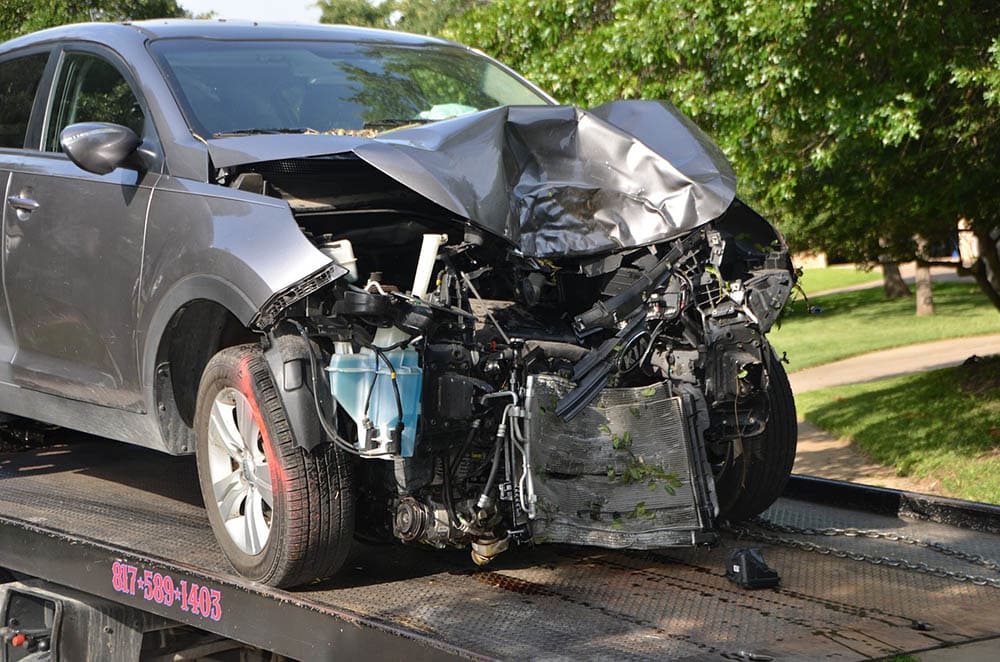
Related Read: Saudi Arabia Car Accident Statistics and Facts
High Driving Statistics
8. 12.4% of Americans believe that high driving has safe levels depending on the THC level of the driver.
(FINDER)
The majority of Americans believe that driving under the influence of cannabis is unsafe. But a large minority believe it’s safe to drive at certain levels of cannabis intoxication.
Many states now have some form of legalized medical marijuana. As a result, it’s crucial to know what THC or marijuana is safe for the driver.
Tetrahydrocannabinol (THC) is the primary psychoactive component of marijuana. THC can be detected in the blood within minutes of inhaling or ingesting marijuana. It can remain detectable for up to three days. It depends on how often someone uses it and the concentration in the blood.
9. Around the world, 44% of drivers involved in fatal accidents tested positive for drugs.
(DRUG ABUSE)
Determining whether drug use played a part in a crash is often complicated. It’s because countries and states vary widely in their testing methods. Some tests screen for certain drugs. Others screen for any substance a patient is taking.
Furthermore, some tests are performed on blood samples, while others are conducted through urine or hair samples.
The frequently changing laws and technology make it difficult to conclude the prevalence of drugs in fatal car crashes. But the report provides some helpful information about the relationship between drug use and driving.
10. The number of accidents caused by drunk drivers worldwide is four times higher than accidents caused by high drivers.
(NHTSA)
We all know that driving when you’re under the influence of alcohol is a bad idea. But, many people still don’t understand how much of a danger it poses.
For example, did you know that the risk of a fatal car crash caused by drunk drivers is four times higher than the risk of a fatal car crash caused by high drivers? That’s right. Even if you aren’t worried about dying in a car accident, driving while high could still cause you to hurt yourself or others.
 Frequently Asked Questions about Drunk Driving vs. High Driving
Frequently Asked Questions about Drunk Driving vs. High Driving
What is the meaning of DUI?
DUI stands for driving under the influence. DUI is used in North America, but the definitions and penalties vary slightly between states and countries. DUI is a serious offense often accompanied by other charges such as reckless driving, hit and run, or vehicular homicide.
This term is used in several countries to refer to drunk driving. Also, DUI refers to an act of driving after consuming alcohol or drugs in a way that renders the driver incapable of operating a vehicle safely. Driving while under the influence of alcohol or drugs includes both legal and illegal intoxicants. Also, it involves prescription medications and even over-the-counter drugs.

Why is drunk driving a massive problem?
Alcohol consumption impairs your judgment. The more you drink, the more likely you’ll make bad decisions. One of those bad decisions could lead to a DUI charge.
Alcohol is also a depressant that causes poor coordination and slower information processing. Also, it can cause dilation of the peripheral blood vessels.
They make it difficult for someone to detect when they’re becoming impaired. Even one drink can impair judgment and reaction time, especially if consumed on an empty stomach.
(SWHELPER)
Apart from driving when drunk or high, what else causes impaired judgment when driving?
Not all impaired judgment is caused by alcohol and other drugs. Some conditions may also impair your driving. One of them is sleep deprivation. No matter how sober you are, driving while sleep-deprived is dangerous. Road trips and late nights out with friends are fun. But it’s never a good idea to drive when you’re sleepy.
Also, tiredness caused by other factors such as long workdays and insomnia can be dangerous. Many prescription medications have side effects that can impair your ability to drive. Besides, certain combinations of over-the-counter medicines can also cause drowsiness and dizziness.
Before getting behind the wheel, check the side effects of any medication you are taking and ensure that you don’t mix it with any of your other medications. If you do need to combine two medications, try to schedule them so that neither one will affect your driving at the same time.
Lastly, weather conditions such as rain, fog, or snow can make it difficult for drivers to see clearly. Likewise, glare from bright sunlight can be distracting and dangerous for drivers.
(CDC)
Which is riskier between drunk driving and high driving?
While many people assume drugged driving is less risky than drunk driving, this assumption couldn’t be further from the truth. Besides, many studies suggest that drunk drivers pose a much greater risk to our roadways than drugged drivers.
Both drunk and high drivers are impaired. But, research shows that being “high” on marijuana may make you more aware of your condition than a driver who is under the influence of alcohol. You might be able to compensate for this impairment better when you’re high than when you’re drunk. But it remains dangerous to drive either way.
(NCBI)
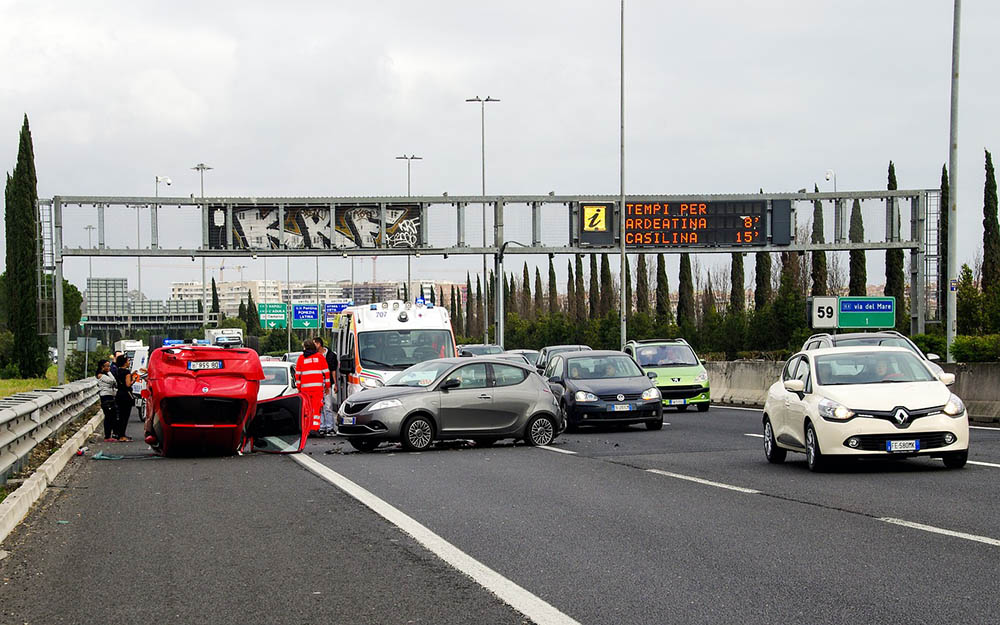
Related Read: 10 Car Accident Statistics and Facts in the US
How do you tell if you are too high to drive?
Driving under the influence is a serious crime. Also, when driving while high or intoxicated with marijuana or any other drug is not a minor offense. The best way to avoid getting into trouble is to avoid driving when you are high or intoxicated.
You may not be able to determine the level of high you are at and whether it’s safe to drive at all. Marijuana can make drivers feel like they have a lower tolerance for alcohol, leading them to drink more than they normally would. It increases their risk of being involved in an accident.
The best thing to do is not drive at all under any circumstances that you may have consumed alcohol.
Is there a correlation between blood alcohol laws and traffic accidents?
Differences in blood alcohol laws may influence the rate of traffic fatalities in a state in two ways.
First, stricter laws may reduce the number of people who drink and drive by raising the perceived risk of driving after drinking. Second, stricter laws may increase the perception of risk associated with drinking and driving. It increases the perceived likelihood that offenders will be caught if they do drive after drinking.
Today, there is a correlation between alcohol laws and traffic accident rates. States that have blood alcohol concentration (BAC) levels of .08 or less have fewer traffic accidents.
The NHTSA has found that states with stricter laws have lower traffic accident rates than those with less strict laws. Besides, it has been argued that the more stringent a state’s law is, the safer its highways are for drivers and passengers.
(NHTSA)
How much does driving under the influence cost per year?
The cost of DUIs is beyond fines and penalties. The financial repercussions of driving under the influence can be vast.
According to a report by the Money Geek, drug and alcohol-related crashes cost $45,000 per year. That includes costs for medical treatment, law enforcement, and lost productivity. Alcohol and drugs are also linked to domestic violence, sexual assault, and child abuse.
(MONEY GEEK)
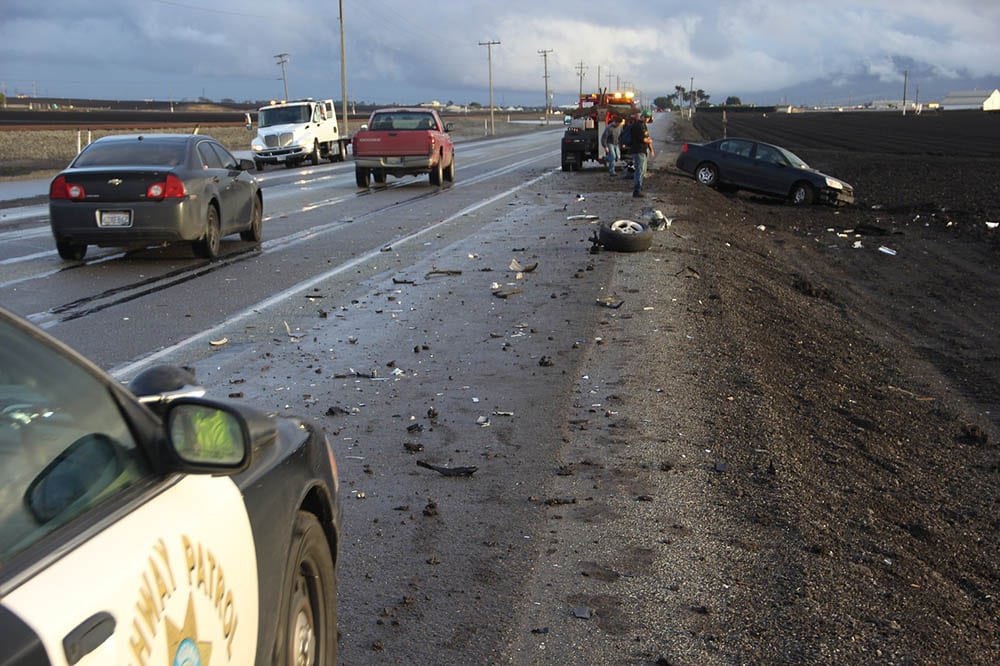
Difference between High Driving and Drunk Driving
High driving is one of the most dangerous undertakings on the road. It’s linked to many deaths and injuries. The long-term effects are unknown. But, it’s known that high driving can cause accidents with severe consequences.
Driving while high is much like traveling while drunk. But there’s a major difference between the two. Both actions involve impaired individuals. Drunk driving has a physical component to it. Intoxicated drivers have a lowered level of mental awareness and control over their bodies.
It’s different from being high, which involves having an altered mental state due to drugs but not a lack of physical coordination or awareness.
Related Read: How Many People Die in Car Accidents Every Year?
Conclusion
Whether you choose to drink or take drugs while driving, both situations are dangerous and unfit for any driver.
When you drink alcohol, you lose your inhibitions. It means you may be more likely to engage in risky behaviors while driving. For example, you might speed or tailgate because you believe you’re a better driver when intoxicated.
High drivers have different concerns than drunk drivers. High driving refers to people who get behind the wheel after smoking marijuana or taking other drugs or medications. Prescription and over-the-counter medicines are also causes of high driving incidents and accidents.
Driving under the influence (whether of alcohol or drugs) is not only illegal but it’s dangerous. Drunk driving is a worse crime because it involves operating a vehicle. Also, the statistics and effects that come with high driving are still noteworthy.
Featured Image Credit: blende12, Pixabay
Contents



 Frequently Asked Questions about Drunk Driving vs. High Driving
Frequently Asked Questions about Drunk Driving vs. High Driving
